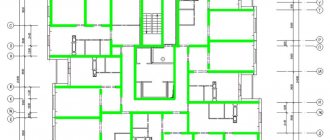Where to begin?
First, about one, but very important nuance - there is no specific system for obtaining administrative permits for the construction of a private house, which can be repeatedly used as a template. The reason for this is TSN - territorial building codes. These are documents of local significance – constituent entities of the Russian Federation.
Nevertheless, a general scheme describing the primary actions for obtaining permits still exists. It represents a procedure prescribed by law and operating at the federal level, but does not take into account local regulatory documents. In this case, all responsibility regarding non-compliance with TSN falls on the owner of the house.
The purpose of the state examination is to ensure compliance with the rights of individuals and legal entities, as well as the interests of the state. The absence of a building permit automatically recognizes the construction as unauthorized construction. And this threatens with a fine and demolition of the facility. Here are the situations that may arise in the absence of an agreed project:
- Violation of environmental requirements or site boundaries - responsibility falls on the owner.
- In case of accidents related to the construction site, the owner is also to blame.
- When there is no house design, the contractors often unreasonably inflate the payment for the work.
The presence of an agreed project can protect the rights of all participants related to the construction of the facility.
Read also: “Construction without a project.”
Source documents
Next, we will determine the basic documents that must be provided for approval:
- The decision of the town planning committee of a constituent entity of the Russian Federation regarding the admission of a person to the construction of residential real estate, carrying out all relevant design and survey activities (important: regardless of the results and level of design and survey work, in the absence of an order, they are invalid).
- A document indicating the size of the plot and its boundaries.
- Construction passport.
- Permission for engineering support of a construction site.
- A specified list of all technical requirements.
- Approved conditions from the General Directorate of Civil Defense.
- Admission for geodetic analysis, as well as site measurements (important: in the absence of such a document, all subsequent work is illegal).
Documents for direct application for construction approval to the administration of the subject:
- An application for a building permit, indicating the planned location (important: the application must be filled out in the prescribed form. Otherwise, it is rejected or not considered).
- Passport and its copy.
- A certified document confirming the right to use the land.
- Site plan - cadastral.
- Approved house design.
- Order from the KGA (Committee on Urban Planning and Architecture) with a positive response.
- Permission to carry out construction work;
- A document indicating geological surveys carried out on the site or the results of a topographic survey.
In addition, it is especially worth highlighting information about a plot whose area exceeds 500 m2. Its owners need to obtain an architectural planning assignment (APZ). This document contains a complete list of requirements that are mandatory during the construction of a facility:
- Environmental, sanitary and fire safety standards.
- Approval of construction in a special manner.
- The obligation not to violate the rights of participants and persons affected by construction, even indirectly.
Documents required to obtain an APL: application and documentary evidence of the right to own the site. After the APL is issued, it will be possible to obtain approval for construction from the interdepartmental body of the subject.
Rules for registering order details
The rules for preparing document details are established by GOST R 6.30-2003 “Unified documentation systems. Unified system of organizational and administrative documentation. Requirements for paperwork”, and are also set out in Appendix No. 11 to clause 3.3.2 of the Methodological recommendations for the development of instructions for office work in federal executive authorities, approved by Order No. 76 of Rosarkhiv dated December 23, 2009 (hereinafter referred to as the Methodological Recommendations). The composition and rules for preparing the details of orders are described in detail in Appendix No. 15 to clause 3.3.5.2 of the Methodological Recommendations.
Let's consider the composition and basic rules for preparing the order details, based on the requirements of GOST R 6.30-2003, Methodological Recommendations and many years of office work practice.
Name of the organization - the author of the document . According to Fig. B.5 of Appendix B to GOST R 6.30-2003 and Appendix No. 15 to clause 3.3.5.2 of the Methodological Recommendations on order forms the full and abbreviated name of the organization - the author of the document is indicated. We believe that in organizations that are not related to executive authorities, taking into account the fact that the order is an internal or , if available, abbreviated name of the organization that authored the document can be indicated If the organization considers it necessary, both options can be indicated on the order forms. The abbreviated name of the organization is indicated in parentheses below the full name.
The name of the organization that authored the document may be in bold font.
Note : Both the full and abbreviated name of the organization are indicated on the general form of the organization, as well as on the letterhead.
The name of the type of document is usually written in capital letters: ORDER or DISTRICT.
The name of the document type may be in bold.
Restrictive marks for the date of the document and its registration number . The date of the order is the date the document is signed ; on the same day the order must be registered. The date of the order is usually issued in digital format, for example: 06/05/2012. Indicating zeros in the example above is mandatory to protect against falsification.
According to clause 3.12 of GOST R 6.30-2003, the registration number of a document consists of its serial number in the registration journal and can be supplemented, at the discretion of the organization, with a case index according to the nomenclature of cases, information about the correspondent, executors, etc. Other requirements for the formation of registration numbers of documents are current legislation does not contain.
In accordance with the registration system adopted by the organization, the serial number of the order can also be supplemented with letter indices. With a small volume of document flow, orders on core activities and on administrative and economic issues, as a rule, do not need additional indexing, and the letter index “l/s” or “k” is added to the numbers of orders for personnel, at the choice of the organization. You can use both indexes: for orders with a storage period of 75 years - the index “l/s”, and for orders with a 5-year storage period - the index “k”.
In organizations with a large volume of document flow, letter indices may be used to indicate the contents of the order and facilitate the identification of documents.
In orders for core activities, these can be the indexes “f” (financing issues), “shr” (approval of the staffing table and making changes and additions to it), “la” (approval of local regulations, making changes to them, their cancellation) and etc.
In orders on administrative and economic issues, you can use indexes such as “p” (repair, reconstruction), “tr” (transport services), “z” (purchase of furniture, stationery, etc.), etc.
In orders for personnel, the indices “km” (secondment), “y” (dismissal), “pr” (hiring and relocation), “oo” (“paid leave” - provision of annual paid leave), “bo” are used (“without pay” – provision of leaves without pay), etc.
The place of preparation or publication of the document , according to clause 3.14 of GOST R 6.30-2003, is indicated if it is difficult to determine it using the details “Name of the organization” and “Reference data about the organization”. The place of compilation or publication is indicated taking into account the accepted administrative-territorial division, using only generally accepted abbreviations.
Despite the fact that reference information about the organization is not indicated on the order forms, and it is not always possible to determine its location from the name of the organization, we believe that this detail may not be indicated in the internal documents of the organization. However, if there are separate structural units located in other localities, the details should be formalized.
If an organization is registered in one city, but carries out its activities and issues administrative documents in another, the details of the order “Place of preparation or publication of the document” indicate the actual place of publication of the document.
The title to the text of the order includes a brief content of the document, is formulated in the prepositional case and begins with the preposition “O” or “About”, for example:
- on the appointment of a person responsible for organizing the processing of personal data (in the order for the main activity);
- on the assignment of vehicles to structural divisions of the organization (in the order on administrative and economic issues);
- on the cancellation of an employment contract (in the order for personnel).
On corner order forms with a flag arrangement of the details, the title to the text is printed directly from the left margin of the document within the boundaries of the zone reserved for the details of the header part of the document, with the centered location of the details - in the center of this zone; if orders are issued on longitudinal forms with the details located centrally, the title to the text is printed in the center of the working line.
Document text . The text of the order may consist of two parts – a statement (preamble) and an administrative one, separated by the administrative word “I order”. The ascertaining part may be missing, and then the order begins with an administrative word.
According to Appendix No. 15 to clause 3.3.5.2 of the Methodological Recommendations, the stating part briefly outlines the goals and objectives, facts and events that served as the basis for issuing the order. It may begin with the words “for the purpose”, “in pursuance”, etc. If the order is issued on the basis of another document, then the ascertaining part indicates the name of this document, the name of the body that issued the document, the date, registration number and title to the text.
If in orders for main activities the stating part is found quite often, then in orders for personnel it is, as a rule, absent. However, in some orders on personnel it is recommended to formalize it: for example, in the stating part of the order on the application of a disciplinary sanction, provide the date and detailed description of the disciplinary offense or violation of official (professional) duties committed by the employee, as well as detail the results of the investigation into this fact.
How to formalize the administrative word “I order” must be decided by the organization itself when designing the order form:
- as a continuation of the last paragraph of the stating part or on a separate line;
- if on a separate line, then directly from the left margin or from the red line;
- capital letters or lowercase letters in space.
The administrative part of the order lists instructions (tasks) indicating executors and deadlines for execution.
The administrative part can be divided into paragraphs and subparagraphs, which are numbered in Arabic numerals . Structural units or specific employees of the organization are indicated as performers.
Note! Making changes to the signed order, instruction, as well as to the agreed draft document is not allowed.
If a particular paragraph of the order is addressed to the heads of all structural divisions of the organization, you can use a generalized wording without indicating specific positions and names, for example:
2. The heads of the Company's structural divisions must submit to the HR department, by December 10, 2012, completed employee survey forms regarding the time of vacation provision in 2013 in accordance with the Appendix.
The last paragraph of the administrative part may indicate the position, surname and initials of the employee who is entrusted with monitoring the execution of the order. If the head of the organization leaves control over the execution of the order to himself, this should not be indicated in the order. The order should not include a clause about the need to bring the order to the attention of certain employees; for this purpose, familiarization visas are issued - on the front or, if there is not enough space, on the reverse side of the last sheet of the order or on a separate familiarization sheet. An acquaintance visa for one employee can be issued according to the following model:
Reviewed by: ______________________ « ____ » _________________________ 20 __ signature (legible) month in words
In the unified forms of orders for personnel, approved by Resolution of the State Statistics Committee of Russia dated January 5, 2004 No. 1, the familiarization visa has a similar structure:
The employee has read the order (instruction): _______________________ « ____ » ______________________ 20 __ signature (legible) month in words
If you need to familiarize several people with the order, you can use a universal form to issue study visas, which allows you to reduce or increase the number of lines:
The following have been familiarized with the order:
_________________________________ _______________________ « ____ » ___________________ 20 __
_________________________________ _______________________ « ____ » ___________________ 20 __
________________________ _______________________ « ____ » ___________________ 20 __ surnames, initials signature (legible) month in words
In the unified forms of multi-subject orders for personnel, a column is provided for familiarization of workers with the order, the heading of which states: “The employee has become familiar with the order (instruction). Personal signature. Date of".
Marking the presence of the application . Clause 3.21 of GOST R 6.30-2003 deals with the preparation of this detail in letters, and with regard to attachments to administrative documents, it is only said that in the attachment to the administrative document, on its first sheet in the upper right corner they write “Appendix No.” indicating the name of the administrative document, its date and registration number. The following is an example of such an inscription:
Appendix No. 2
to the order of Rosarkhiv
dated 06/05/2003 No. 319
It is allowed to print the expression “APPENDIX No.” in capital letters, and also to center this expression, the name of the document, its date and registration number relative to the longest line.
The Methodological Recommendations also say nothing about making a note about the presence of an application in orders and instructions. Appendix No. 11 to clause 3.3.2 of the Methodological Recommendations provides for the use of a mark on the attachment when preparing attachments to orders and instructions, but by a mark on the attachment we mean a mark that is placed in the upper right corner on the attachment itself to the administrative document (see. higher).
This Appendix also provides explanations that supplement and clarify the rules for preparing annexes to orders given in GOST R 6.30-2003. For example, it is clarified that a note about the attachment is placed on the first sheet of the attachment for reference to orders, instructions, rules, instructions, regulations, plans, programs, agreements and other documents. If the attachment to a document (for example, an order) is an approved document (regulations, rules, instructions, regulations, etc.), a mark about the attachment is placed in the upper right corner, and below is the approval stamp of the document, for example:
Appendix No. 1
Approved
by order of Rosarkhiv
dated 12.11.2009 No. 125
The absence in GOST R 6.30-2003 and Methodological Recommendations of a mention of the mark on the presence of an application in administrative documents allows us to draw the following conclusion: this detail is not formalized in administrative documents, and links to applications are given directly in those paragraphs of the order to which these applications relate. For example:
I order:
1. Until January 1, 2013, the logistics department will purchase office furniture for the office according to the list given in Appendix No. 1 to the order.
Responsible – head of the logistics department N.S. Sharov.
[…]
The signature consists of three elements: the name of the position, the personal signature and its decoding. The transcript of the signature consists of the initials and the surname separated from them by one space, for example: N.G. Fedorov.
On order forms, you can pre-provide a form for this detail, for example:
____________________________ ____________________ ___________________________
job title signature signature description
The detail “Note about the performer” is issued in orders if the organization considers it necessary. The details include the initials, surname and telephone number of the executor of the document. According to clause 3.27 of GOST R 6.30-2003, a mark about the executor is placed on the front or back side of the last sheet of the order in the lower left corner directly from the left margin, for example:
NOT. Sharapova 8-495-123-45-67
On unified forms of orders for personnel, a mark about the executor is not provided by the State Statistics Committee of Russia, but it can be added, of course, if the organization considers it necessary. According to the Procedure for the Application of Unified Forms of Primary Accounting Documentation, approved by Resolution of the State Statistics Committee of Russia dated March 24, 1999 No. 20 (hereinafter referred to as the Procedure for the Application of Unified Forms), the changes made must be formalized by the relevant organizational and administrative document of the organization.
Font and paragraph parameters used when creating orders . The organization independently determines:
- font type used when placing orders;
- font size for individual order details;
- the ability to use bold style to highlight individual details;
- size of line spacing;
- how paragraphs are aligned (justified or left);
- the need and size of additional spacing between paragraphs.
When preparing organizational and administrative documents, the font Times New Roman, Arial or another one of the organization’s choice is usually used.
According to established practice, when typing the text of an order, its heading, job title and transcript of the signature in the “Signature” attribute, the font size is set to 12 pt, but if necessary, it can be reduced to 11 pt or increased to 14 pt.
The name of the organization - the author of the document, the name of the type of document can be highlighted in a font 2-3 pt larger than the font of the document text.
The size of the line spacing is set in the range from single to double. Single spacing usually includes a title for the text and a note about the artist. The text of the order is usually printed at one and a half intervals. The same line spacing can be set for all order details. If necessary, you can use intermediate (fractional) line spacing values, for example, set it to 1.25.
The requirements of GOST R 6.30-2003 for the format and rules for writing dates apply only to the “Document Date” attribute, writing the date in the text of the document, incl. and is not regulated in orders or regulatory documents. The date in the text can be written in both digital and verbal-digital format, for example: 12/06/2012 or December 6, 2012, and instead of “year” The word “year” may be written; the zero before the number “6” is not required.
The pages of orders are numbered in accordance with the rules set out in clause 4.9 of GOST R 6.30-2003: when preparing documents on two or more pages, the second and subsequent pages are numbered (the first page is not numbered), page numbers are placed in the middle of the top margin of the sheet.
The organization has the right to establish its own rules for typing text and other details of orders and enshrine them in the instructions for office work or other local regulations.
Project approval
First of all, a coordinated project is a guarantor of the legality of the construction of the facility. The legislation of the Russian Federation regulates the preliminary state examination and only after that the construction of the building begins. This procedure is mandatory regardless of the form of ownership of the future object or the allocated sources of finance for its construction. If there is no at least one approval or examination regarding the object, it is considered illegal.
Examinations and approvals
Departmental examination, according to paragraph 1.5 of the Government of the Russian Federation No. 1008, can be carried out exclusively by federal bodies that have the authority to conduct it.
- The first examination is environmental. It is carried out by the State Committee for Environmental Protection before a decision is made on the implementation of the project. It is not necessary to carry out it everywhere, since Federal Law No. 7 “On Environmental Protection” establishes a specific list of cases and objects when examination is required. Nevertheless, it is not recommended to completely ignore the examination, even when the law does not imply it.
- The second is the examination of design and estimate documentation. It is carried out according to the procedure specified in Russian Government Decree No. 585. The cost is determined according to the scope of work, similar to environmental. The final conclusion must be sent to the department of state architectural and construction supervision. If there are no objections, a document is issued confirming the legality of the construction of the object.
Initial permitting documentation, including technical documentation, is submitted to specific approval authorities. Approval is issued in one of the available forms: letter, expert opinion or documented decision. In exceptional cases, only affixing a seal on the project from the appropriate authority is allowed.
Now, as for agreement with each authority:
- Architectural and planning documents. Approved by the leading architect of the construction company and provided in three copies. In special cases, they can be signed by the deputy architect.
- Confirmation from the State Center for Sanitary and Epidemiological Surveillance. This is a conclusion signed by the city’s chief physician or his deputy.
- Approval from the Office of Civil Defense. It is presented in the form of a conclusion and signed only by the head of the department.
- Conclusion of the improvement committee. Issued in the form of an opinion from committee experts.
- Confirmation by the Committee for State Control, Use and Protection of Historical and Cultural Monuments. It is required only in cases where the construction of an object is planned on the border with a zone of protected cultural heritage. In a number of regions, construction near such zones is strictly prohibited, and therefore you need to find out about the possibility in advance. It is presented in the form of a letter.
Separately, it is worth highlighting the situation when it is planned to build on the border territory of two or more constituent entities of the Russian Federation, or in the border zone of the Russian Federation. In this case, according to the Civil Code of the Russian Federation, a construction permit is issued by a federal body, and not by a body of a specific subject of the Russian Federation.
Further possibilities
It is necessary to take into account that the validity period for approval of project documentation is 2 years. When it expires, everything will have to start again. Therefore, you immediately need to calculate your own strengths and financial capabilities - plan the necessary buildings so as not to change the project.
Changes to the project are possible, but subject to a preliminary examination. This is especially true in cases where the changes made affect the safety of the facility. There are several nuances worth noting here:
- Expertise of the changes being made is not always required. An exception may be cases when the changes do not concern safety or do not increase the estimate.
- When making changes to design characteristics, expertise is always required.
- If you receive a negative response from the examination, there are two options: go to court or change individual shortcomings according to the recommendations of experts.
Correcting the project and making additions is possible, but only when the examination confirms the safety of these changes.
A little about guarantees
In the legislation of the Russian Federation for 2021, there are no specific regulations that regulate the statute of limitations on the quality of work. However, this does not mean that the customer of the house is defenseless. There are several options:
- Firstly, there is a business custom regulated by Art. 5 of the Civil Code of the Russian Federation - it requires the indication of the limitation period in the contract - the category “Warranty obligations”. It operates on the principle of self-government - people make preliminary agreements among themselves in order to avoid conflict situations.
- Secondly, if there is no such category, the customer has the right to turn to Art. 724 Civil Code of the Russian Federation. In accordance with it, if the warranty period is not established, then a claim for improper performance of work is brought within two years. The expiration date begins on the day the object is handed over. If this deadline is missed, the customer can also make demands on the contractor, but he will have to prove that errors in the results were made before the delivery of the object.
- Thirdly, according to Art. 761 of the Civil Code of the Russian Federation - a construction company bears full responsibility for incorrectly drawn up technical documentation. This means that if mistakes are made on the part of the construction company, then, at the request of the home owner, it is obliged to correct all the work free of charge, which does not meet the standards. The house plan is also eligible for reimbursement.
Thus, in the absence of warranty obligations being included in the contract, it is possible to demand compensation for losses from the contractor. However, the claim must be filed within a reasonable time - about two years after the delivery of the object.
Power supply project
Power supply project
Preparing a power supply project for an apartment or country house involves creating a completely new wiring, grouping electricity consumers according to their maximum power. During design, the information necessary to select the type and cross-section of cable in an apartment or country house, and the characteristics of protective equipment is collected and evaluated. Errors in calculations lead to the fact that the power supply project does not ensure complete safety of the facility after completion of the work. To protect yourself and your loved ones from short circuits, fires, threats to property or your own life, use the design services of Mosenergosbyt JSC. At a fair price, they are highly professional and help apartment owners:
- comply with the rules of electrical installation in the apartment;
- optimize the apartment’s power supply scheme, increase the efficiency of electricity consumption;
- eliminate power outages thanks to accurate calculation of the load in the project.
There are no restrictions on the complexity of project operations or the area of premises.
How does Mosenergosbyt JSC work?
When drawing up a project for the electrical supply of an apartment, our employees individually evaluate each object. Therefore, in contrast to standard design, the area, the owners’ wishes for the placement of sockets and lighting in the apartment are taken into account, and protective devices and components with a suitable price are selected. If it is necessary to increase the design capacity, it will also be impossible to carry out approvals without a separate project. We design the power supply for apartments in the complex, taking into account the grouping of consumers by room, power, and the optimal amount of electricity for consumption. Thanks to professionalism in drawing up projects, the time for their implementation is immediately determined accurately. The work in the apartment is delivered strictly within the agreed time frame, and the price is optimal. If necessary, we will select building materials, electrical equipment and even undertake their purchase. We draw up power supply projects for apartments within the Moscow Ring Road and Moscow Region. When designing, we adhere to a well-established scheme:
- pre-project consultations, calculations - after filling out the client’s application, our electrical engineers will come to the apartment or country house, take measurements for the power supply project and clarify the price;
- drawing up technical specifications, final estimates - the costs of preparing the project depend on the area of the facility, the number of power consumption points, installed equipment, and other factors;
- agreeing on the terms of the contract, drawing up a project according to the facility plan - with grouping of consumers, calculating the load on the groups.
- if necessary - electrical installation of equipment, cables in the apartment according to the project plan and diagram - from gating, drilling walls and dismantling old wiring to installing modern meters and checking the electrical system for the design voltage.
To prepare the project, you will need a technical specification, a document on the permissible power and a diagram with a power supply panel. When designing power supply, we take into account all SNiPs, PUE requirements, and fire safety.
To order a cost estimate or receive advice on an apartment power supply project, leave a request on the website or call us by phone. We will coordinate a convenient visit for engineers and carry out work in the apartment, tell you about payment and composition.











